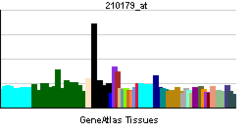KCNJ13
| KCNJ13 | |||||||||||||||||
|---|---|---|---|---|---|---|---|---|---|---|---|---|---|---|---|---|---|
| Identifiers | |||||||||||||||||
| Aliases | KCNJ13, KIR1.4, KIR7.1, LCA16, SVD, potassium voltage-gated channel subfamily J member 13 | ||||||||||||||||
| External IDs | MGI: 3781032 HomoloGene: 55638 GeneCards: KCNJ13 | ||||||||||||||||
| Targeted by Drug | |||||||||||||||||
| dalfampridine[1] | |||||||||||||||||
| |||||||||||||||||
| RNA expression pattern | |||||||||||||||||
  | |||||||||||||||||
| More reference expression data | |||||||||||||||||
| Orthologs | |||||||||||||||||
| Species | Human | Mouse | |||||||||||||||
| Entrez | |||||||||||||||||
| Ensembl | |||||||||||||||||
| UniProt | |||||||||||||||||
| RefSeq (mRNA) | |||||||||||||||||
| RefSeq (protein) | |||||||||||||||||
| Location (UCSC) | Chr 2: 232.77 – 232.78 Mb | Chr 1: 87.39 – 87.39 Mb | |||||||||||||||
| PubMed search | [2] | [3] | |||||||||||||||
| Wikidata | |||||||||||||||||
| View/Edit Human | View/Edit Mouse |
Potassium inwardly-rectifying channel, subfamily J, member 13 (KCNJ13) is a human gene encoding the Kir7.1 protein.[4]
See also
References
Further reading
- Kubo Y, Adelman JP, Clapham DE, et al. (2006). "International Union of Pharmacology. LIV. Nomenclature and molecular relationships of inwardly rectifying potassium channels". Pharmacol. Rev. 57 (4): 509–526. doi:10.1124/pr.57.4.11. PMID 16382105.
- Krapivinsky G, Medina I, Eng L, et al. (1998). "A novel inward rectifier K+ channel with unique pore properties". Neuron. 20 (5): 995–1005. doi:10.1016/S0896-6273(00)80480-8. PMID 9620703.
- Partiseti M, Collura V, Agnel M, et al. (1998). "Cloning and characterization of a novel human inwardly rectifying potassium channel predominantly expressed in small intestine". FEBS Lett. 434 (1–2): 171–176. doi:10.1016/S0014-5793(98)00972-7. PMID 9738472.
- Döring F, Derst C, Wischmeyer E, et al. (1998). "The epithelial inward rectifier channel Kir7.1 displays unusual K+ permeation properties". J. Neurosci. 18 (21): 8625–36. PMID 9786970.
- Derst C, Döring F, Preisig-Müller R, et al. (1999). "Partial gene structure and assignment to chromosome 2q37 of the human inwardly rectifying K+ channel (Kir7.1) gene (KCNJ13)". Genomics. 54 (3): 560–563. doi:10.1006/geno.1998.5598. PMID 9878260.
- Nakamura N, Suzuki Y, Sakuta H, et al. (1999). "Inwardly rectifying K+ channel Kir7.1 is highly expressed in thyroid follicular cells, intestinal epithelial cells and choroid plexus epithelial cells: implication for a functional coupling with Na+,K+-ATPase". Biochem. J. 342 (2): 329–36. doi:10.1042/0264-6021:3420329. PMC 1220469
 . PMID 10455019.
. PMID 10455019. - Strausberg RL, Feingold EA, Grouse LH, et al. (2003). "Generation and initial analysis of more than 15,000 full-length human and mouse cDNA sequences". Proc. Natl. Acad. Sci. U.S.A. 99 (26): 16899–16903. doi:10.1073/pnas.242603899. PMC 139241
 . PMID 12477932.
. PMID 12477932. - Gerhard DS, Wagner L, Feingold EA, et al. (2004). "The status, quality, and expansion of the NIH full-length cDNA project: the Mammalian Gene Collection (MGC)". Genome Res. 14 (10B): 2121–2127. doi:10.1101/gr.2596504. PMC 528928
 . PMID 15489334.
. PMID 15489334. - Kimura K, Wakamatsu A, Suzuki Y, et al. (2006). "Diversification of transcriptional modulation: large-scale identification and characterization of putative alternative promoters of human genes". Genome Res. 16 (1): 55–65. doi:10.1101/gr.4039406. PMC 1356129
 . PMID 16344560.
. PMID 16344560.
External links
- KCNJ13 protein, human at the US National Library of Medicine Medical Subject Headings (MeSH)
This article incorporates text from the United States National Library of Medicine, which is in the public domain.
This article is issued from Wikipedia - version of the 5/20/2016. The text is available under the Creative Commons Attribution/Share Alike but additional terms may apply for the media files.